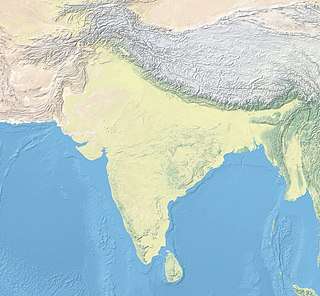Nigali Sagar
| Nigali Sagar pillar of Ashoka | |
|---|---|
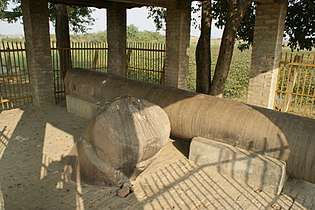 The Nigali Sagar pillar, one of the pillars of Ashoka. | |
| Material | Polished sandstone |
| Size |
Height: Width: |
| Period/culture | 3rd century BCE |
| Discovered | 27°35′41.7″N 83°05′44.9″E / 27.594917°N 83.095806°ECoordinates: 27°35′41.7″N 83°05′44.9″E / 27.594917°N 83.095806°E |
| Place | Nigalihawa, Nepal. |
| Present location | Nigalihawa, Nepal. |
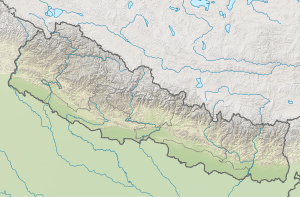 Nigali Sagar | |
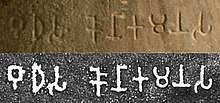
Nigali Sagar is an archaeological site in Nepal containing the remains of a pillar of Ashoka. The pillar is called the Nigali Sagar pillar, or also the Nighihawa pillar, or Nigliva pillar, or Araurakot Asoka Pillar. The site is located about 20 kilometers northwest of Lumbini and 7 kilometers northeast of Taulihawa, Nepal.[1]
Kanakamuni Buddha
It is said that in this place the Kanakamuni Buddha, one of the Buddhas of the past, was born.[2] The Asoka inscription engraved on the pillar in Brahmi script and Pali language attests the fact that Emperor Asoka enlarged the Kanakamuni Buddha's stupa, worshiped it and erected a stone pillar to mark the birthplace of Kanakamuni Buddha on the occasion of the twentieth year of his coronation.
The Nigali Sagar Edict
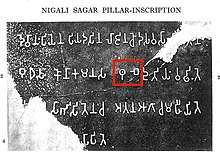
The inscription, made when Emperor Asoka visited the site in 249 BCE and erected the pillar, reads:
Brahmi script and Pali language:
Devanam piyena piyadasin lajina- chodasavasa bhisitena
Budhasa Konakamanasa thube-dutyam vadhite
Visativa sabhisitena –cha atana-agacha-mahiyite
silathabe-cha usa papite“His Majesty King Priyadarsin in the 14th year of his reign enlarged for the second time the stupa of the Buddha Kanakamuni and in the 20th year of his reign, having come in person, paid reverence and set up a stone pillar”.[3][4]
Because of this dedication by Ashoka, the Nigali Sagar pillar has the earliest known record ever of the word "Stupa" (here the Pali word Thube).[5]
There is also a second inscription, "Om mani padme hum" and "Sri Ripu Malla Chiram Jayatu 1234" made by King Ripu Malla in the year 1234 (Saka Era, corresponding to 1312 CE).
Accounts of the pillar
The Chinese pilgrims Fa-Hien and Hiuen-Tsang describe the Kanakamuni Stupa and the Asoka Pillar in their travel accounts. Hiuen Tsang speaks of a lion capital atop the pillar, now lost.
 Pillar stump and inscription of Ashoka.
Pillar stump and inscription of Ashoka. Inscription by Ashoka.
Inscription by Ashoka. Rubbing of the inscription.
Rubbing of the inscription. Full length of the pillar.
Full length of the pillar. 13th century inscription by King Ripu Malla.
13th century inscription by King Ripu Malla. Inscription of a bird.
Inscription of a bird. Another general view.
Another general view.
References
| Wikimedia Commons has media related to Ashoka Pillar, Nigali Sagar. |
- ↑ Lumbini development trust report
- ↑ Political Violence in Ancient India by Upinder Singh p.46
- ↑ Basanta Bidari - 2004 Kapilavastu: the world of Siddhartha - Page 87
- ↑ Inscriptions of Asoka. New Edition by E. Hultzsch (in Sanskrit). 1925. p. 165.
- ↑ Amaravati: The Art of an early Buddhist Monument in context. p.23
